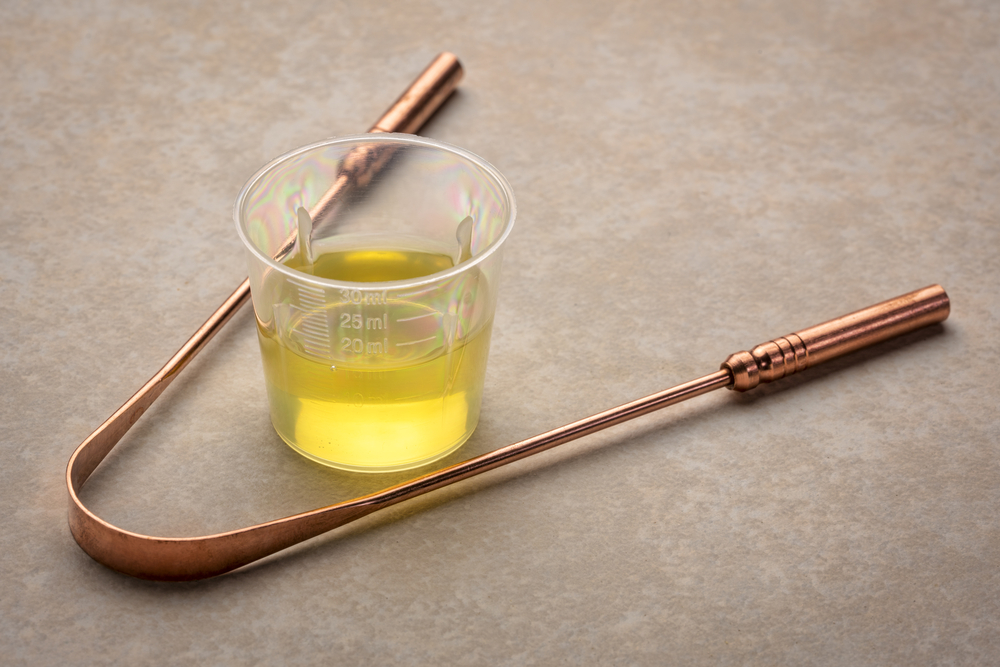
In this Selfie World we live in, we all want a beautiful smile and sparkling white teeth, isn’t it? Read further for Ayurveda’s three steps to oral care.
According to a nationwide survey, approximately sixty-seven percent of the Indian population have never visited a dentist and still enjoy healthy teeth. How is this possible? The answer lies in Ayurveda’s three steps to oral care.
And the three steps are as follows:
- Step 1: Ayurvedic Toothbrushing
- Step 2: Ayurvedic Tongue scraping
- Step 3: Ayurvedic Gargling in one of the following two ways:
- Oil pooling: holding a large amount of fluid in the oral cavity
- Oil pulling: swishing a small amount of liquid in the oral cavity
Step 1: Ayurvedic Toothbrushing
Ayurveda considers toothbrushing an art, and once you master this toothbrushing art, you can count on long-lasting healthy white sparkling teeth. Ayurveda recommends cleaning your teeth with a soft botanical brush made of natural plant material.
So first, let’s talk about what Ayurveda calls a Nature’s Disposable Toothbrush, aka a neem chew stick. A Neem stick is a herbal chew stick with natural bristles that you can throw away or eat after brushing your teeth.
You might be asking, how the heck do I brush my teeth with a neem stick? Just like that, bite and chew on it. When you bite and chew on the herbal stems, it exercises the gums, polishes the teeth, stimulates salivary flow, and helps plague control.
But isn’t that precisely what our modern nylon-bristled toothbrushes accomplish, too; cleaning the teeth, massaging the gums, removing stuck particles and plague? Yes, but with less aggression.
Chewing sticks have been used for ages throughout Asia, Africa, the Caribbean, and South America and are considered an effective tool for oral hygiene by the World Health Organization.
A study published in the North American Journal of Medical Sciences found that the chew stick is as effective as a toothbrush and sometimes even more effective.
Benefits of a natural neem stick:
- The herbal stems have an antimicrobial effect on oral bacteria, and when biting and chewing on the stick, the herbs are transmitted via the tongue into the oral cavity.
- The bitter taste of the neem helps remove toxins, unpleasant odors, and rubbish from the teeth, tongue, and mouth, leaving the mouth refreshed.
The best time to use a chewing stick is right after waking up and right before going to bed. However, some people chew on neem wood after every meal.
If you have symptoms of a cold, flu, or any conditions of concern, it is best to consult your doctor before using a neem stick.
Step 2: Ayurvedic Tongue Scraping

The second of Ayurveda’s three steps to oral care is cleaning or scraping the tongue. When you scrape the tongue, you remove all nasty taste and food waste from the mouth.
As per Ayurveda the tongue is an organ of elimination with deep pockets that accumulate all the toxins the body tries to eliminate when we sleep. By scraping the tongue daily, you get rid of these excess toxins, minimize infections and keep your mouth fresh.
Tongue scraping has been practiced in India for ages and is now gaining momentum in the West.
The journal of the American Dental Association has published several articles on tongue cleaning, agreeing that cleaning the tongue potentially reduces breath odor and tongue coating. Numerous online research studies in the United States have shown that dentists are increasingly recommending daily tongue cleaning as part of oral care routine to prevent periodontal disease.
As stated in a review on the “effectiveness of mechanical tongue cleaning on breath odour and tongue coating,” scraping the tongue has the potential to reduce breath odor successfully.
Ayurvedic tongue scraping is easy to practice; however, Ayurveda recommends investing in a proper scraper because most people use plastic and stainless steel tongue scrapers. So what is a good Tongue Scraper according to Ayurveda?
Based on the Ayurveda sages, a good tongue scraper is:
- A scraper curved in a U-shape
- The blade should not be too sharp-edged
- Preferably gold, silver, copper, tin, or brass
Tongue scrapers are not expensive at all. I use one I purchased in India, but it can be found online and in most natural food stores. Copper is sweet, astringent, and bitter, plus it heals mouth ulcers and tongue sores.
Step 3: Ayurvedic Gargling

Ayurveda’s third and most famous step to oral care is the well-known gargling.
Mouthwash
Ayurvedic mouthwashes have been studied for centuries. They are made of ingredients excellent for oral health which support the development of teeth and gums, such as medicinal oils and herbs that are entirely natural.
In the article “Antiseptic Mouthwash Can Kill You,” the American neurosurgeon C. Norman Shealy firmly states that “Antiseptic mouthwash kills the good bacteria in the mouth and is the most damaging things people do to themselves.”
The preferred choice for gargling as per Ayurveda is sesame oil and water. Gargling with cool water is good for eliminating toxins and alleviating thirst. While gargling with lukewarm water relieves the gums and provides a sensation of lightness in the mouth. However, Ayurveda highly recommends using organic raw, cold-pressed sesame oil.
The Ayurvedic Wisdom believes gargling with sesame oil strengthens the gums and jaw muscles and is extremely useful for those who sing or speak as a profession. In addition, it reduces tooth decay and plaque buildup and is excellent for anti-aging as it strengthens facial muscles and prevents wrinkles!
Ayurvedic Gargling Techniques:
Oil pooling
Oil pooling is when you fill the mouth fully with the gargling liquid, holding it for about three to five minutes until the eyes begin to water. While the liquid is being held (aka pooled) in your mouth, do not wiggle nor swallow because it is when you fill your mouth so utterly that you can’t move the liquid around that the liquid penetrates and works its magic.
Oil pulling
Oil pulling is when you take a regular dose of liquid into the mouth and gargle. As you gargle, make sure the oil touches all surfaces inside the mouth, this will allow it penetrate between the teeth. Swish and wiggle for about one to three minutes.
When it comes to oil pulling, it is not how long you gargle, but it is the daily practice and consistency that works the magic.
Gargling the Ayurvedic way is best done first thing in the morning upon awakening. However, if you are very ambitious and want to gargle twice a day, you can gargle before bedtime as well. It is ok to drink water before gargling; however, gargling should be done on an empty stomach or at least three hours after eating.
After gargling with oil, it is ok to rinse quickly with water to get rid of the leftover oil. And eating gargling is fine, the food even tastes better.
Similar to the neem stick, if you have symptoms of a cold, flu, or any conditions of concern, consult your doctor before oil pooling or pulling.
Summary
So are you ready to smile for your next selfie and shine those sparkling white teeth? Here you have it, Ayurveda’s three steps to oral care for a beautiful smile and sparkling white teeth.
- Step 1: Ayurvedic Toothbrushing
- Step 2: Ayurvedic Tongue scraping
- Step 3: Ayurvedic Gargling in one of the following two ways:
- a. Oil pooling: holding a large amount of fluid in the oral cavity
- b. Oil pulling: swishing a small amount of liquid in the oral cavity
Please note to always follow the three steps in the order given. Start with toothbrushing, followed by tongue scraping, and end with gargling (oil pooling or oil pulling).
To learn more about Ayurveda and the Ayurveda Lifestyle:
If you enjoyed the Ayurveda’s three steps to oral care, please make sure to leave us a comment below. We love to hear from you.